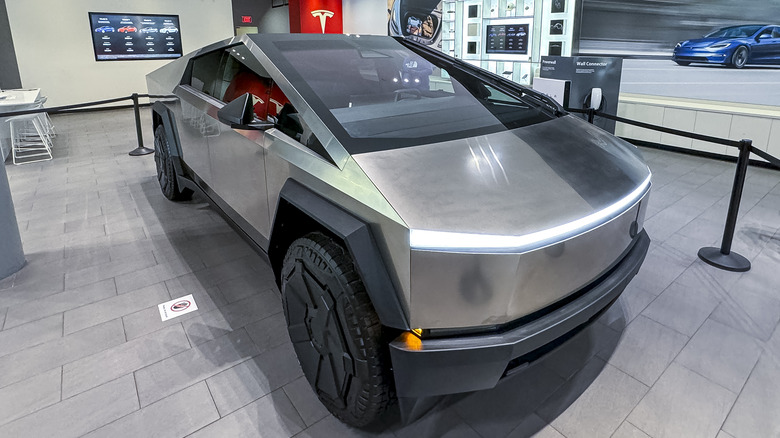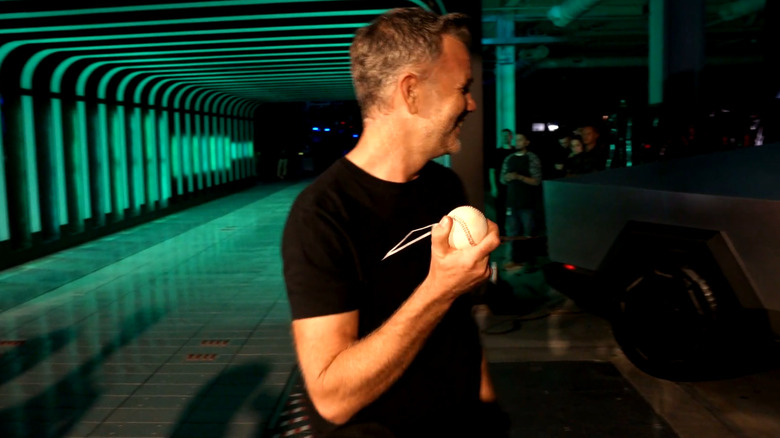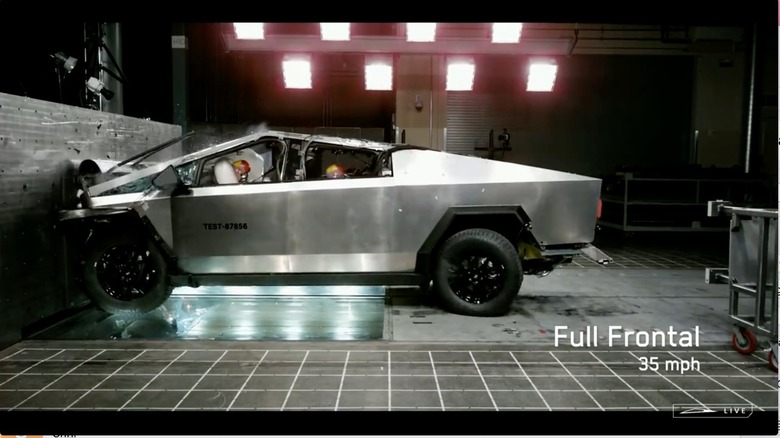Everything Wrong With Tesla's Cybertruck Unveiling Event
After years of delays and disappointments, Tesla finally delivered its first Cybertrucks to a "lucky" few of its long-suffering customers on November 30. The handover came at the end of a presentation showcasing the truck's features, righting some apparent wrongs, and putting it head-to-head with several popular vehicles.
However, all wasn't exactly what it seemed. Some of Tesla's claims during the Cybertruck delivery event could be politely described as padded, or less politely described as utter nonsense. They relate to the truck's performance, durability, and safety record — amongst other things. This isn't that much of a shock. Musk has a history of making elaborate claims, and being a bit liberal with the truth. Those claims have covered everything from Mars colonization to concerns over neural implants, and a lot of the billionaire's misplaced optimism has centered on the Cybertruck too. Delivery date, build quality, pricing, and specs are all areas where the goalposts have moved drastically since 2019.
Now the dust has begun to settle, let's take a closer look at some of Tesla's latest claims, and why we think Elon Musk may not have been entirely forthcoming with certain assertations about the Cybertruck.
The windows are probably not ball-proof
One of the big stories to come out of the Cybertruck's initial 2019 unveiling relates to the durability of its windows. The supposedly bulletproof panes shattered when lead designer Franz von Holzhausen pitched a metal ball at them. This wasn't a one-off, as both a front and rear window were destroyed by the steel sphere. During the handover ceremony, this appeared to be a wrong Musk and Co were determined to right. The billionaire directly referenced the previous failure, before directing his colleague to pitch a ball at the windows as hard as he possibly could. The windows held this time, with the ball in question bouncing off harmlessly. Unfortunately, this whole charade was arguably the biggest question mark of the day.
Instead of a steel ball, like the one that currently has a 2-0 record against Tesla's windows, a baseball was pitched at the windows instead. Obviously, a hard, dense, metal ball is going to make a far greater impact than a sphere made of glue, string, and leather. Given the obvious switch, we can only conclude that a steel ball would still shatter the Cybertruck's side windows without too much trouble. If the original durability issues had been resolved, von Holzhausen would have undoubtedly tossed another lump of metal at the windows without any fear.
Bulletproof is a strong word
Baseballs aren't the only sporting goods the Cybertruck is resistant to, allegedly. It can also stop a podcast host's "armor-piercing arrow," and even laugh off machine gun fire. While this is technically correct, and Tommy guns are pretty cool, it's also weighted in the Cybertruck's favor somewhat.
The .45 ACP a Thompson spits out is a large, (relatively) slow, pistol round. There's also a chance the rounds used weren't jacketed, which would slow them down even more and decrease their penetration further. The relatively short barrel of the Thompson means that the bullets didn't have a lot of room to build up speed, again making them a bit less lethal to the truck. The Cybertruck also shrugged off a few 9mm rounds, which again is pistol ammo.
We have to wonder what would happen if a 5.56 mm round fired from America's favourite rifle (the AR-15) would fare against the Cybertruck? We'd wager a more powerful .30 caliber rifle round blasted from Grandpa's old hunting rifle would likely go through both sides of the Cybertruck and subsequently into whatever was parked behind it. It's also telling that all of these tests focused on the doors and not the windows. Any Cybertruck owners who have annoyed a certain elk-hunting podcast presenter should probably be careful. If he goes head hunting with those arrows, the outcome may very different.
The Porsche drag race was another gimmick
The Cybertruck beating a Porsche 911 in a drag race while towing a second 911 is certainly a powerful image. The 911 celebrated its 60th anniversary in 2023, and over those six decades, it has arguably established itself as the quintessential sports car. However, as with pretty much everything else showcased during the presentation — it's closer to a piece of propaganda than a demonstration of the Cybertruck's prowess.
The 911 isn't really a dragster. If Tesla wanted to flex the Cybertruck's muscle against an ICE car designed for pure straight-line speed, they could have thrown it in against a Dodge Demon and watched it get absolutely toasted. Porsche's own EV, the Taycan Turbo, would also beat the best of the Cybertruck family in a drag race. With a 0-60 time of 4.0 seconds, the base 911 isn't a slouch by any means, but there is a long list of EVs that will dominate it in a sprint. That list includes the GMC Hummer EV, which is a bit like the Cybertruck but actually available to buy and not absolutely hideous.
To top it off, the Cybertruck can allegedly go from 0-60 in 2.9 seconds — but that's the near-$100,000 tri-motor version. Both the basic and dual-motor trucks would have lost that race against the Porsche — with 0-60 times of 4.5 and 6.5 seconds respectively. On the flip side, if the test pitted top-of-the-line against top-of-the-line, a 2023 911 Turbo would again beat the Tesla hands down.
Crumple zones, who needs 'em?
The Cybertruck's handover event had a bit of a safety showcase too, with a reel of crash test footage being played. The Cybertruck impacted a wall, and shrugged off a vehicle hitting it from the side, seemingly emerging pretty much unscathed both times. As Musk pointed out, "If you're ever in an argument with another car you will win."
Pre-2000s Volvos were a bit like this too. In fact, the Swedish brand built a bit of a reputation that you could smash something like a 940 through the side of a house and it would simply reverse out and keep going afterward. Unfortunately, the person behind the wheel probably wouldn't. Crumple zones didn't catch on because manufacturers like the fact their vehicles become scrap metal when a driver crashes. They caught on because they absorb a lot of energy that would otherwise turn the driver's organs into soup. So while your Cybertruck may "win" that argument against the other car, that could actually be the last thing you do.


